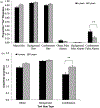Memory binding and theta EEG during middle childhood
- PMID: 33959957
- PMCID: PMC9020213
- DOI: 10.1002/dev.22124
Memory binding and theta EEG during middle childhood
Abstract
The ability to bind together the contextual details associated with an event undergoes dramatic improvement during childhood. However, few studies have examined the neural correlates of memory binding encoding and retrieval during middle childhood. We examined age-related encoding and retrieval differences using continuous electroencephalogram (EEG) measures in a sample of 6- and 8-year-olds. For the memory binding task, children were tested on memory for individual items (i.e., objects and backgrounds only) and combined object-backgrounds pairings (combination condition). Memory for individual item information was comparable across both age groups. However, younger children experienced greater difficulty (i.e., higher false alarm rate) in the combination condition. Theta (4-7 Hz) neuronal oscillations were analyzed to compare memory encoding and retrieval processes. Widespread retrieval-related increases in theta band EEG power (compared with baseline and encoding-related activation) were evident in both 6- and 8-year-olds. Regression analyses revealed that parietal theta EEG power during retrieval accounted for variability in memory binding performance. These findings suggest that theta rhythms are intricately linked to memory binding processes during middle childhood.
Keywords: EEG power; encoding; memory binding; middle childhood; retrieval.
© 2021 Wiley Periodicals LLC.
Conflict of interest statement
CONFLICT OF INTEREST
The authors declare no conflict of interest.
Figures





Similar articles
-
Distinct slow and fast cortical theta dynamics in episodic memory retrieval.Neuroimage. 2014 Jul 1;94:155-161. doi: 10.1016/j.neuroimage.2014.03.002. Epub 2014 Mar 12. Neuroimage. 2014. PMID: 24632089 Clinical Trial.
-
A frequency band analysis of two-year-olds' memory processes.Int J Psychophysiol. 2012 Mar;83(3):315-22. doi: 10.1016/j.ijpsycho.2011.11.009. Epub 2011 Nov 30. Int J Psychophysiol. 2012. PMID: 22137966 Free PMC article.
-
Frontal midline theta oscillations during working memory maintenance and episodic encoding and retrieval.Neuroimage. 2014 Jan 15;85 Pt 2(0 2):721-9. doi: 10.1016/j.neuroimage.2013.08.003. Epub 2013 Aug 8. Neuroimage. 2014. PMID: 23933041 Free PMC article. Review.
-
Frontal-posterior theta oscillations reflect memory retrieval during sentence comprehension.Cortex. 2015 Oct;71:205-18. doi: 10.1016/j.cortex.2015.06.027. Epub 2015 Jul 15. Cortex. 2015. PMID: 26233521
-
EEG alpha and theta oscillations reflect cognitive and memory performance: a review and analysis.Brain Res Brain Res Rev. 1999 Apr;29(2-3):169-95. doi: 10.1016/s0165-0173(98)00056-3. Brain Res Brain Res Rev. 1999. PMID: 10209231 Review.
References
Publication types
MeSH terms
Grants and funding
LinkOut - more resources
Full Text Sources
Other Literature Sources

